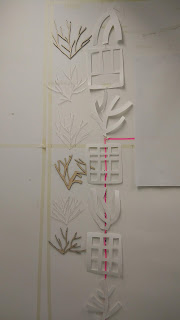Unit x week 7
In the last week before the Easter break, I spent most of
the time in the print room, making my first table runner repeat prints. This was
a long process, which I was nervous about doing as I have never printed on such
a large scale before, or with a repeat print. I needed help from the technicians
in order to place the screen correctly, ensuring that the pigment didn’t smudge.
The whole printing process took two days in the print room, and from start to
finish, including making the screens, involved a lot of concentration and
overcoming challenges. However, I am really glad that I have now done it, so I will
be able to do it again for this project. I am pleased with how the table runners
came out, despite some issues. For example, when laying down the backing cloth
and pining out the fabric, I pinned it too close to the edge of the cloth, so
that the screen couldn’t lie flat for the final repeat. This mean that when
applying adhesive for flocking, the glue was patchy and therefore didn’t take
the flock fibres evenly. I will bear this in mind when I next prepare my fabric
for printing.
Additionally, the flocking process was nerve-wracking. I was
conscious that this would be the riskiest element, as I had already done the
pigment layer, so if the flock went wrong it would affect what was already
there. Unfortunately, the large heat press was broken, so I had to use the
smaller one. I found it tricky to get the pressure right all over the fabric, meaning
that it was patchy in places, and I had to go back in and fill spaces that had
missed the heat afterwards. Although by the end I managed to fill most of the
gaps, it could be a lot neater, so next time I will ensure that I can use the
larger press before I apply the flocking. I will also need to test how long to leave
the flock under the heat on the fabric before I try this again, as it slightly singed
the fabric; this wasn’t too bad, and wouldn’t necessarily be noticed, but I know
that it has altered the colour of the print slightly so would aim to avoid this
in future.
 |
| My fabric during the printing process. |
Ultimately, I am really happy with how the printing went, as
I have learned a lot from it in terms f how to make my final samples the best
they can be, as well as learning how to screen print in repeat, something which
I have long been keen to do but unsure of how to.
Following on from this, I have also dyed some fabric to use
for backing the table runners. I will be stitching a lighter cotton to the
reverse of the fabric and then turning it inside out to neatly hem it. This will
be difficult as it is 2 meters long, but as it will just need a straight stitch
it shouldn’t be too problematic. I have dyed some cotton green using direct dye
and over the Easter holiday will be experimenting with natural dyes such as
turmeric and avocadoes. I want to get a range of vibrant but natural shades, as
the collection is intended to be quite bold with a homemade feel.
Along with the table runners I will also be creating napkins
in the same way, and making visualisations of my work on ceramics, to see how
my designs could work as a whole tableware collection.
During this week I also spent time laser cutting Persepex
pieces to embellish onto my abstract screen-printed designs. These will be dyed
using disperse dyes to give them a coloured tint and then handstitched onto the
fabric. I plan for these large-scale pieces to be mounted on stretchers and
hung as original, one-off pieces for the degree show, and visualise them working
on various scales, from A3 to A1.
 |
| Large scale prints to be embellished and single colour designs to turn into napkins. |
Over the Easter holiday I will focus on digital designs, so
that when I get back to Uni I can have these digitally printed straight away. I
also plan to make up as many of my napkins and table runners as possible and
dye fabric. On top of this, I will develop another collection of designs
inspired by floral imagery and research.







Comments
Post a Comment